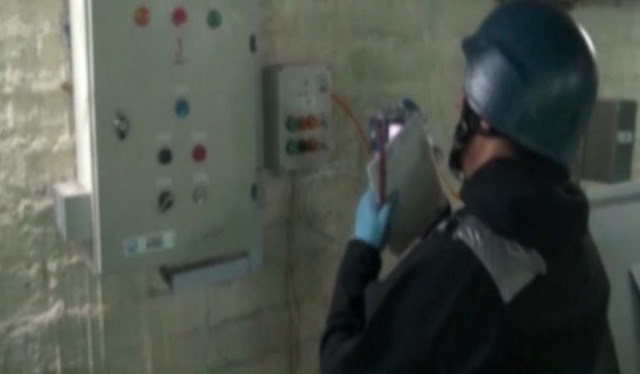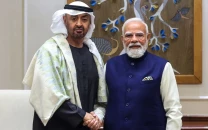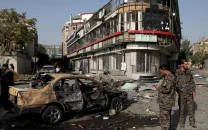All Syria chemical weapons placed under seal: watchdog
The OPCW said earlier that Syria's declared chemical arms production equipment had been completely destroyed.

An image taken from Syrian television shows an inspector from the OPCW at work at an undisclosed location in Syria on October 8, 2013. PHOTO: AFP
"All stocks of chemical weapons and agents have been placed under seals that are impossible to break," Organisation for the Prohibition of Chemical Weapons spokesperson Christian Chartier said, adding that the seals were "tamper proof."
"These are 1,000 tonnes of chemical agents (which can be used to make weapons) and 290 tonnes of chemical weapons," Chartier told AFP in The Hague.
The OPCW said earlier that Syria's declared chemical arms production equipment had been completely destroyed.
Inspectors had until Friday to visit all chemical sites and destroy all production and filling equipment in accordance with a timeline laid down by the OPCW and a UN Security Council resolution.
The resolution stating that the arsenal must be destroyed by mid-2014, was agreed by the United States and Russia to avert military strikes on Syria after deadly chemical weapons attacks near Damascus in August.
The West blamed those attacks, which killed hundreds of people, on President Bashar al-Assad's regime, which denied all responsibility, instead blaming the attack on rebels.
Washington said it was "increasingly confident" the chemical arsenal would be eliminated by June 30th of next year.
"Our target dates are ambitious but they are achievable. We have the support of the international community," Thomas Countryman, a senior State Department official in charge of non-proliferation issues, told US lawmakers.
OPCW head of field operations, Jerry Smith, told the BBC his team had "personally observed all the destruction activities."
"They are not now in a position to conduct any further production or mixing of chemical weapons."
Smith said inspectors went to all but two of Syria's 23 chemical weapons sites, and that the contents of the last two sites -- in areas considered too dangerous to visit -- had been moved to sites the inspectors did check.
"Therefore we have visited and seen the destruction of all Syria's declared chemical weapons (production) capability," he said.
IHS Jane's Consulting hailed the inspection "milestone" but cautioned that the work was far from over, noting that Syria's entire existing chemical arsenal is still under regime control.
"This is a very hurried process that has significant and real uncertainty associated with it. Only when the weapons are destroyed or removed from Syria will it be complete," IHS Jane's director David Reeths told AFP.
The inspectors' progress report came as Brahimi met in Damascus with opposition members tolerated by the regime, part of a regional tour to garner support for proposed peace talks, dubbed Geneva II. He travels to Beirut on Friday.
The veteran Algerian diplomat has been struggling to persuade a wary regime and an increasingly divided opposition to attend the conference.
On Wednesday, he met Assad for less than an hour, during which the president criticised foreign interference in Syria.
"The Syrian people are the only ones who have the right to decide on Syria's future," state media quoted Assad as telling Brahimi.
Earlier this month, Assad cast doubt on the possibility of his regime attending the Geneva talks, saying he would not negotiate with any group tied to the rebels or to foreign states.
The main opposition National Coalition has said it will refuse to take part in any talks unless Assad's resignation is on the table, and rebel groups have warned participants will be considered traitors.
More than 120,000 people have been killed in the 31-month rebellion against the Assad regime triggered by his bloody crackdown on Arab Spring-inspired democracy protests.
Thousands more have been detained both by the regime and by rebels, and many civilians, including foreign journalists, have gone missing, some abducted by jihadist groups.
One of those kidnapped, Polish photojournalist Marcin Suder, managed to escape his captors and is back home, Poland's foreign ministry said Thursday.
Suder, a 34-year-old freelancer who worked for the Corbis agency and other outlets, was abducted by masked gunmen on July 24 during a raid on a media centre in Saraqeb, in the mainly rebel-held northwestern province of Idlib.
On the battlefield, regime forces advanced in Sfeira, an area near the northern city of Aleppo where the army maintains several arms factories, the Syrian Observatory for Human Rights said.
It also reported a rebel mortar attack on Jaramana, a mixed Christian-Druze suburb of Damascus, that killed two women and wounded several people.











1733130350-0/Untitled-design-(76)1733130350-0-208x130.webp)







COMMENTS
Comments are moderated and generally will be posted if they are on-topic and not abusive.
For more information, please see our Comments FAQ